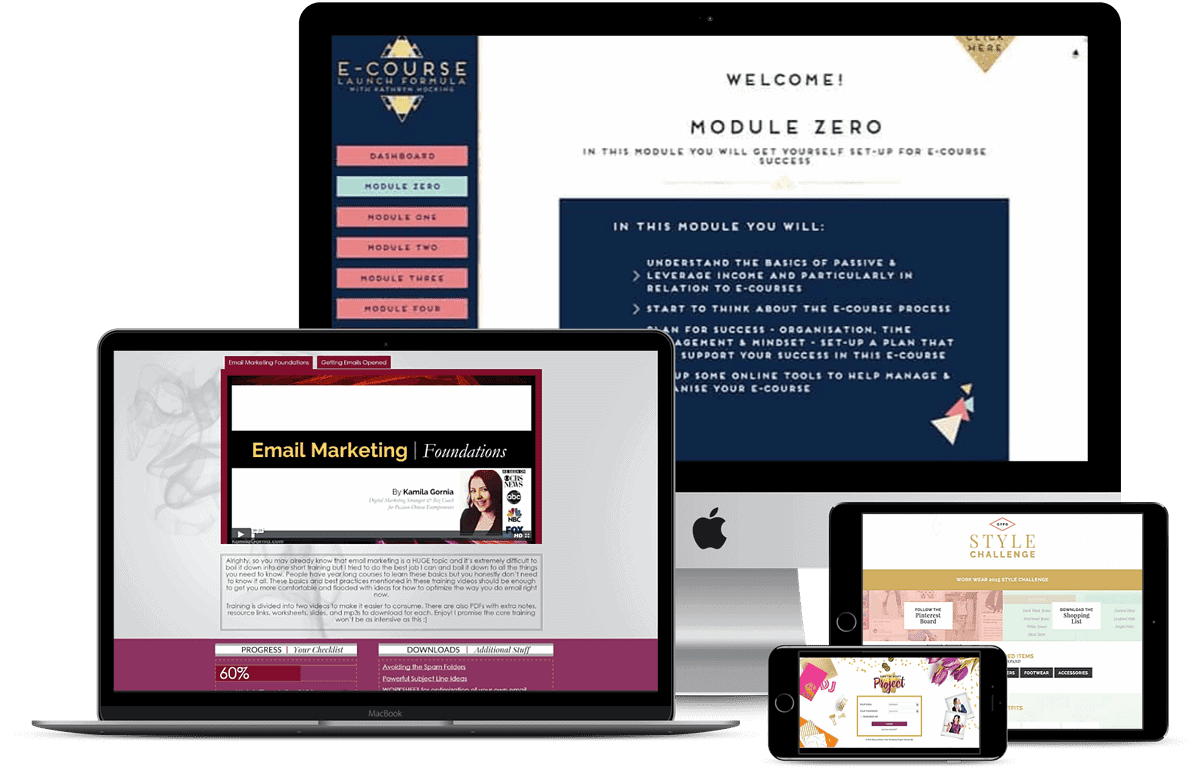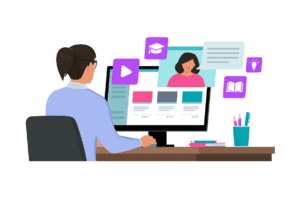There are a lot of terminologies used to describe and define online learning. From different education theories, benefits, and instructional methods, the list is long.
In this post, we’re going to focus on the term asynchronous learning. But first, let’s get a better understanding of what asynchronous learning is.
Asynchronous Learning Defined
Asynchronous learning is defined as an online learning environment that allows students to view instructional training videos and materials at any time the student is ready to learn.
The learner has full control and flexibility over their learning schedule.
What’s the difference between synchronous and asynchronous learning?
The biggest difference between synchronous and asynchronous learning is that asynchronous learning does not include a live component that requires the student to show up at a scheduled time.
Synchronous online learning requires a student to log in to their online learning portal at a specified time to participate in a live lecture or form of instructional training.
A great example of asynchronous learning is a self-guided online course or membership site that gives students access to a library of courses that they can work through at their own pace to help them reach their goals.
Synchronous learning is widely used in the education industry where instructors host a live lecture for the students and has been a popular form of teaching for a lot of schools that were forced to transition to virtual learning during the pandemic.
Let’s dive deeper into some of the benefits and best practices instructors and course creators can leverage with asynchronous online learning.
We’ll also share strategies that can be implemented to best support your students in an asynchronous learning environment.
Benefits of Asynchronous Learning
Now that you’re familiar with the asynchronous learning definition, let’s take a closer look at four benefits of asynchronous online learning.

1. Learners Can Work at Their Own Pace
Asynchronous learning allows each person enrolled in a program to learn at their own pace on their own schedule. There may be a deadline or recommended timeframe for completion to help keep students on track and engaged, but ultimately they can work through the material at their own pace.
Asynchronous learning environments allow learners to access and complete lectures, readings, homework or assignments, and quizzes at any time.
If a student knows they have better focus time in the morning, or perhaps late at night, they’re able to determine their own learning scheduled thanks to asynchronous learning.
This flexibility is one of the biggest benefits of asynchronous learning. It rewards learners who work quickly but also supports learners who need additional time to work through the material.
2. Students Can Repeat Lessons to Maximize Retention
Another benefit of asynchronous learning is being able to repeat the course material and lessons more than once.
Since students are able to digest the material inside an asynchronous online learning environment at their own pace and on their own time, they can revisit the material on an as-needed basis to help maximize retention.
If an online course has video or audio components as part of the instructional materials students are able to pause and rewind as needed. Or they can watch and listen to the material more than once or as a refresher prior to a quiz or assessment.
This is extremely advantageous in comparison to a live lecture where you may miss part of the presentation if you lose focus or aren’t able to take notes fast enough.

3. Students Receive Immediate Feedback
Another benefit of asynchronous learning is that students can receive immediate feedback.
When online courses include assessments or quizzes in an asynchronous learning environment, a student is able to receive their grade or scores immediately upon completion because the grading is automated.
Instructors can even build an online community, create discussion boards or forums to support asynchronous learning.

Having this online discussion area encourages group interactions amongst students and provides them with an additional outlet to receive real-time support and ask questions that other members of the community may be able to provide answers to.
This is extremely beneficial to students if they need support right away or outside of an instructor’s office hours.
Easily Track Student Progress
In an asynchronous learning classroom, instructors and course creators can use gamification and progress-tracking strategies to keep students engaged and progressing through the course content and material.
Checklists are a great progress tracking tool that can be implemented to ensure students are working through the material.

When rewarded for completing a lesson or being able to track their progress and see how much of the course is completed, online learners will remain engaged and committed to their success.
Instructors or course creators can also unlock additional resources or bonus content that students can access as a reward when they complete the course content or pass a quiz.
Issuing a certificate of completion when all of the course content is complete is another way to motivate students and encourage the completion of a course or program.
Examples of Asynchronous Learning
Some of the most common asynchronous learning activities include:
- Pre-recorded video lectures or tutorials
- Audio lectures
- Quizzes
- Certifications
- Employee onboarding and training
- Online courses
- Discussion boards
Who is Asynchronous Learning For?
Many entrepreneurs, including authors, coaches, consultants, wellness professionals, and industry experts have leveraged online courses and memberships to increase revenue.
Being able to share their expertise through asynchronous learning makes it easier than ever to scale their businesses and increase their target market to a global audience.
Asynchronous learning also supports the many businesses that are transitioning to remote-first work environments and moving their traditional in-person workshops online. Through the use of learning management systems and membership site software, it is easier than ever to set up asynchronous online portals for onboarding and employee training.
Learn more about the best LMS and membership software on the market.
How to Build an Asynchronous Learning Environment
Synchronous and asynchronous learning portals can be built using a learning management system or membership plugin.
Using this type of software allows an instructor to restrict access to paying members or authorized students and users. These tools create a unique login that allows students to access course content and instructional materials.
Additional advantages of asynchronous learning include being able to create personalized experiences for your students and scalability – both of which can be achieved with a sophisticated LMS plugin such as AccessAlly.



